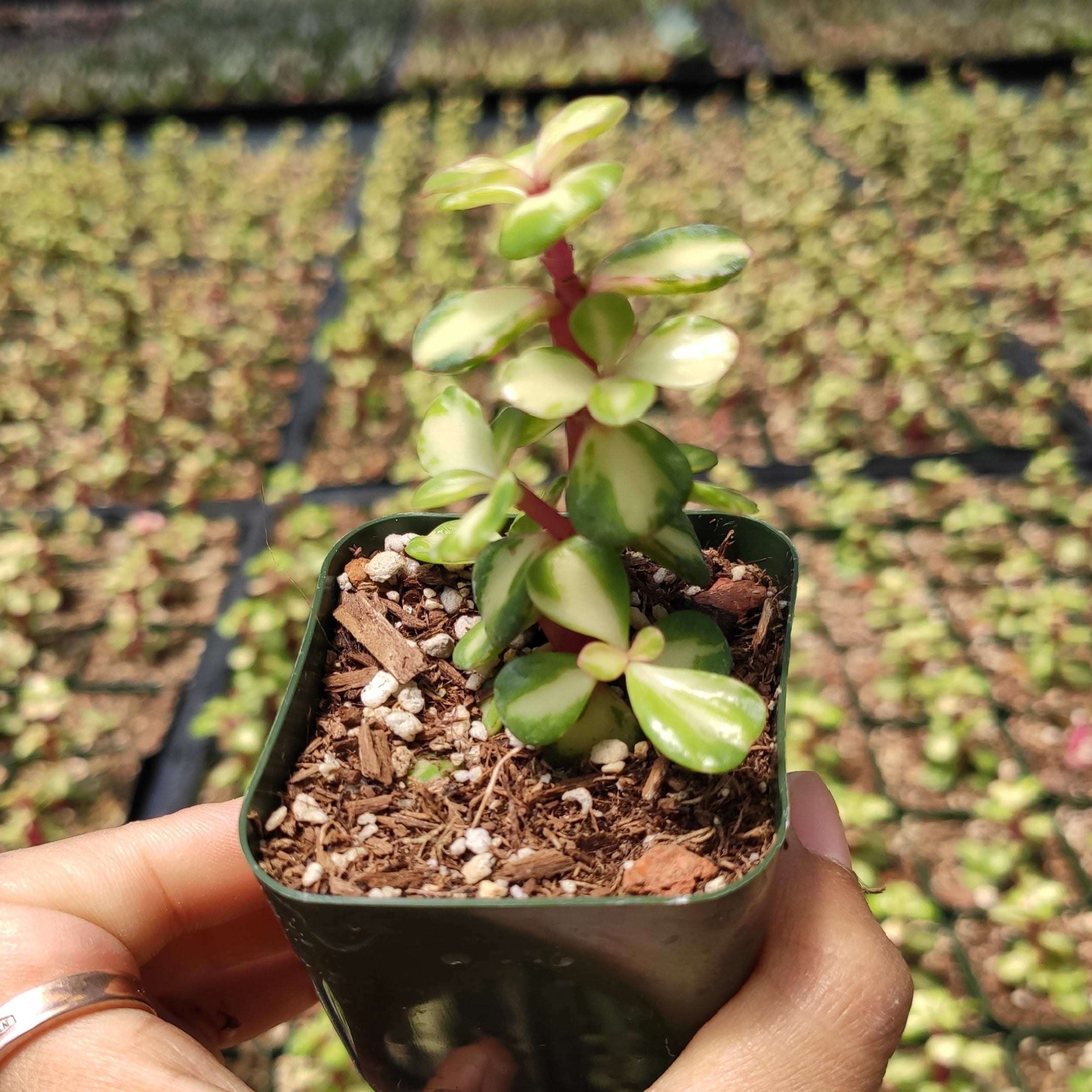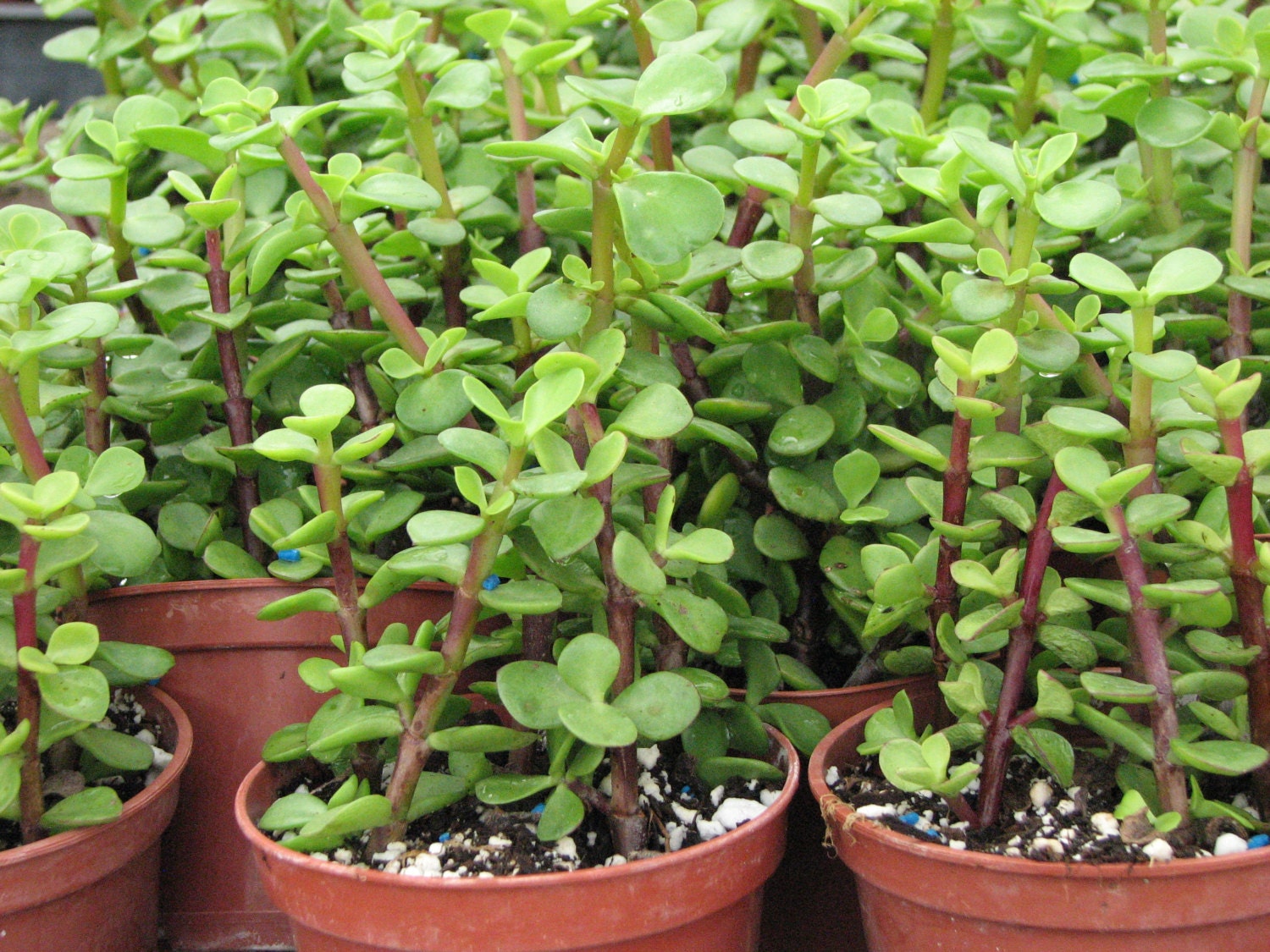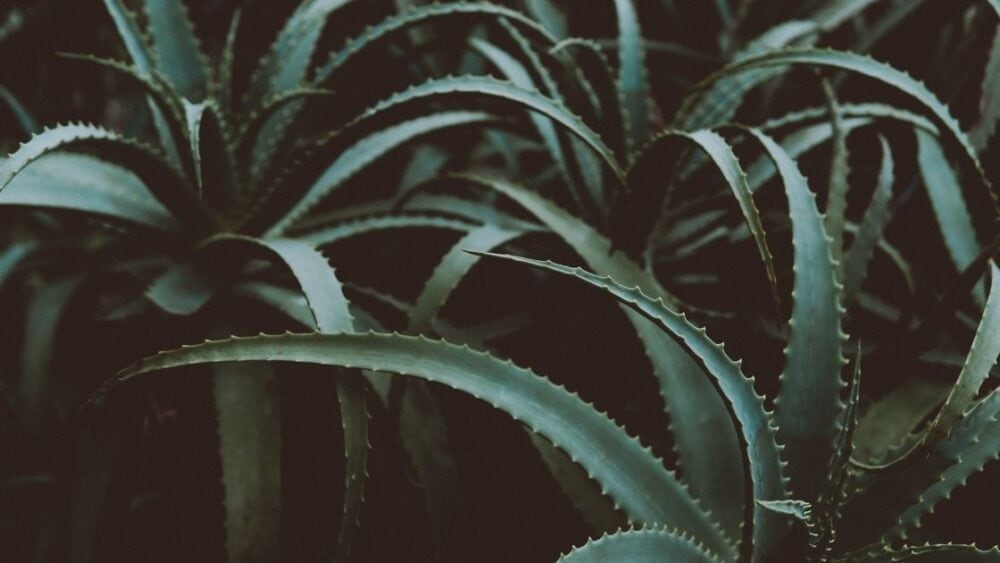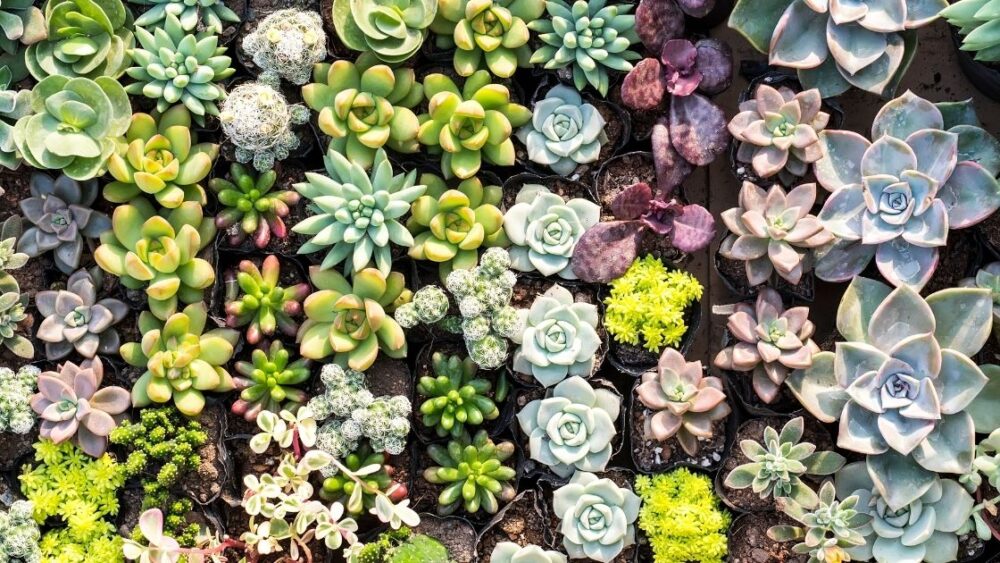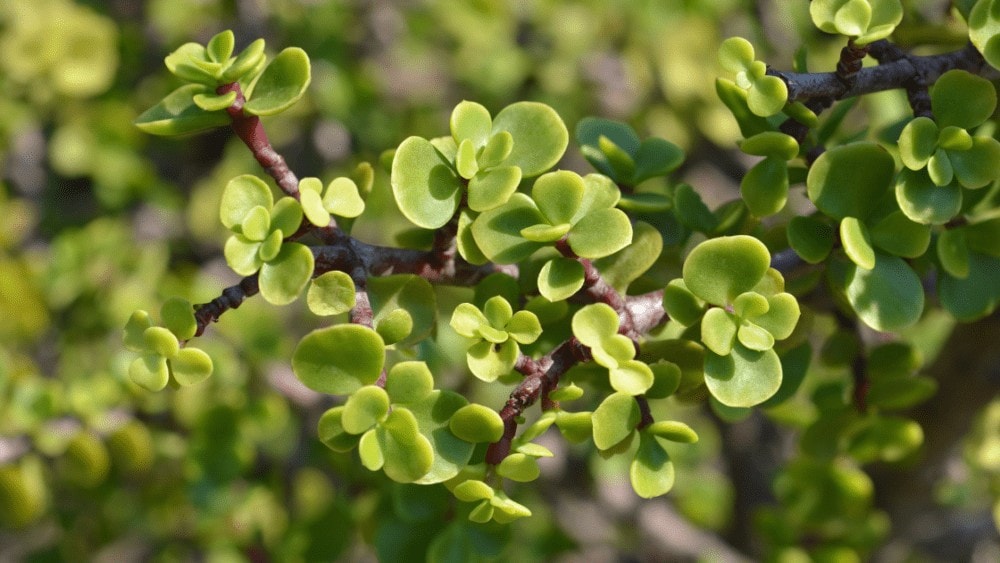
Because of its thin, long stems, this succulent is prone to wilting if the growing conditions aren’t ideal. In addition to wilting, the leaves of the succulent may start becoming yellow and falling off. Fortunately, the problem is easy to diagnose and the causes are usually very basic – an unsuitable, soil, lack of sunlight, improper watering or heat stress.
Elephant Bush Basics
The Elephant bush (Portulacaria afra) is a great addition to any succulent collection – it’s an African succulent with beautiful, dark-red colored stems and thick green leaves. Compared to most other succulents, it’s very fast-growing and in optimal conditions can reach up to 7 feet long. For that reason, it grows best outdoors, but should be moved indoors during the winter – it is not frost tolerant and can’t survive winter outside below USDA zone 10. In the coming paragraphs, we’ll take a closer look at those causes, learn how to identify them and learn what we can do to fix the problem!
Browse our Affiliate Products
What Can Cause an Elephant Bush Succulent to Start Wilting Or Losing Leaves?
Wilting occurs when the plant has trouble transporting enough water to its leaves. This can be caused by over-watering, under-watering, lack of energy due to insufficient sunlight or by poor, compacted soil.
In rare cases, the cause of the problem may remain a mystery and may be related to sudden stresses the plant has been exposed to, such as wide temperature swings, pests and diseases or others. Here are the most common causes of wilting in this succulent:
Over-watering
Causes
Watering too frequently without letting the soil dry up a bit. This causes oxygen starvation of the roots and they can no longer pump water effectively.
Symptoms
The plant starts wilting or losing leaves after being abundantly watered.
Solution
Reduce the watering frequency and move the plant to a shaded location until it recovers. Misting can give the plant more time to recover while greatly limiting further leaf dehydration.
Detailed explanation
A well-known phenomenon which succulent lovers often encounter is paradoxical wilting that comes from watering too often. The more the plant is watered, the more dehydrated its leaves appears to become, which can cause great confusion.
This confusion will immediately disappear when you realize the mechanism behind this phenomenon:
Water displaces most of the available oxygen in the root zone of the plant and the roots can no longer ‘breathe’. Although the aerial parts of all plants photosynthesize and ‘exhale’ oxygen, the situation in the root zone is inverted: the roots consume oxygen and use it to oxidize sugars created by the leaves, liberating energy in the process.
The plant uses this energy to pump water upwards. This is why succulents should be watered infrequently – as the soil dries up, air is ‘sucked’ in between the soil particles, keeping the roots well oxygenated.
Overwatering can lead to both temporary and long-term problems. If proper watering is quickly resumed, and the wilted plant is moved away from direct sunlight, it usually recovers quickly on its own. However, prolonged root suffocation can eventually progress to root rot, which can permanently destroy a large portion of root tissue.
To find a wide variety of succulents, Check out our affiliates below.
Root rot
Causes
Compacted soil or prolonged over-watering can starve the roots of oxygen so much that they begin to die. Soon, anaerobic bacteria start decomposing the dead roots. High soil temperature can also lead to root rot.
Symptoms
The plant starts wilting inexplicably and the wilt steadily worsens over the course of a few days or weeks, regardless of what you do. Moving the plant away from sunlight may help, but it often doesn’t completely eliminate the problem.
Solution
Repot the succulent in fresh soil and get rid of dead root tissue. Limit heat stress while it recovers and develops new roots.
Detailed Explanation
Root rot usually sets in after a week or two of watering too frequently, without letting the top layer of the soil dry up. It can cause severe wilting and leaf loss in Elephant bush succulents and the only solution is to repot the plant in fresh soil, after removing as much of the dead root tissue as you can.
Dead roots are easy to spot and are usually black and unhealthy-looking. Once the plant is repotted, it’s ability to recover will depend on how much of the root has been affected and removed. In severe cases, you may want to cut back the succulent to reduce the aerial surface area that demands water.
In almost all cases, the plant will need to be moved away from the direct sun for at least a few weeks. The plant may also recover without repotting if left for long enough away from the sun, but repotting usually has a higher success rate.
Heat Stress
Causes
The plant is exposed to more heat than it’s used to. As a result, the roots can’t keep up with the water demand of the leaves.
Symptoms
Your Elephant bush succulent starts wilting when exposed to direct sunlight or high heat, but recovers within hours of being moved indoors or to a more shaded location. Watering it more doesn’t appear to help much.
Solution
Slowly acclimatize the plant to direct sunlight over the course of 1 to 2 months.
Detailed explanation
Succulents purchased from nurseries aren’t always used to dealing with the heat of the sun, even though they have no trouble doing so in their natural habitat.
The solution is simple and involves gradually exposing your Elephant bush succulent to longer and longer periods of direct sunlight, or moving it first to partial shade for a few weeks. Misting can be a quick way to help the plant recover. In severe cases, the plant may lose a lot of leaves, but once the heat stress is removed it will bounce back up.
Other, Less Common Causes
The Elephant bush succulent is more prone to wilting compared to other, thick-bodied succulents. Sometimes, the problem can remain a mystery, but if it persists, it’s a good idea to repot the plant and see if that fixed the problem.
Make sure to inspect your plant for bug infestations, which can be quickly dealt with by using isopropyl alcohol or insecticide sprays. The succulent can die quickly if it’s exposed to sub-freezing temperatures and there’s little you can do to revive it if that happens. Over-fertilization can also cause wilting.
What Other Problems Are Common When Caring For Elephant Bush Succulents?
The Elephant bush succulent isn’t prone to problems and is quite resistant to unfavorable conditions. However, it’s not hardy at all and will not survive sub-freezing temperatures. It isn’t more prone to bug infestations compared to other succulents.
Optimal Growing Conditions & Care Tips
Now let’s go over the optimum growing conditions of the Elephant bush succulent. As you’re about to see, this plant has very similar requirements to other African succulents and also experiences winter dormancy. When planted in a suitable, well-draining soil and given plenty of light, this succulent doesn’t require any extra care.
Take a look at these offers below
How Much Sunlight is Necessary?
When exposed to longer periods of direct sunlight, this succulent will grow faster. If you don’t want fast growth, you can expose it to only 2-3 hours of direct sunlight daily and keep it in indirect sunlight for the rest of the day. During the colder and shorter winter days, it will stay in dormancy and will not grow much, regardless of the light intensity.
Optimum Temperature for Growth
The Elephant bush succulent isn’t very picky when it comes to the ambient temperature. The only requirement is that you never expose it to sub-freezing temperatures. It will grow well outdoors in the summer in most locations. During the winter, a cold windowsill will work great for inducing dormancy.
What Type of Soil is Required?
This is an African succulent that requires the same well-draining soil used for all other succulents. A general purpose cactus potting mix will work great and during the summer, fertilizing once or twice per month with dilute cactus fertilizer will greatly speed up growth.
How Much Water Does it Need?
It’s best to judge the water needs of this succulent by keeping an eye out for any wilting and by gauging the moisture of the soil surface. Let the surface dry out a bit between each watering. During the winter, this succulent needs very little water – up to 10 times less than during the summer. Watering excessively during winter will lead to many problems, including wilting and yellowing of the leaves.
Can it be Planted Outdoors?

It’s best to keep the Elephant bush succulent in movable containers and place them outdoors only during the summer. This is a tropical, African succulent that doesn’t encounter sub-freezing temperatures in its natural habitat.
Some people have reported that it can survive winter outdoors, but this is highly variable and depends on the humidity, nighttime temperatures and other factors. If you live above USDA zone 10, you can keep this succulent outdoors year-round, but there is still some risk associated with the occasional temperature drops. For more reading on the different pots, check out this article, What is the perfect pot for my plants?
My Elephant Bush Appears To Be Dying – What Should I Do?
The most common cause of sick-looking Elephant bush succulents is improper watering. The leaves can turn yellow, start to fall off and the whole plant may start wilting. We already explained why that happens and how to fix it. If the plant appears to be dying and nothing you do seems to help, you can ‘re-start’ it by taking cuttings and rooting them.
Even unhealthy-looking stems should be able to root and give life to a new plant. The best strategy for attempting to revive dying elephant bush succulents is to repot them in a fresh new soil after making sure that the root system looks healthy.
Effects of Unfavorable Growing Conditions
The Elephant bush respond to unfavorable conditions similarly to other succulents. If the plant receives only a few hours of direct sun every day, but is in a bright enough spot to properly sync its 24h light cycle, it will simply not grow as quickly.
This can be desirable for succulents you want to keep small. However, if the plant receives only indirect sunlight that is less than 5000 lux in intensity, it may not be able to survive at all. The symptoms of light deficiency are easy to recognize and involve leaf discoloration and poor growth. The plant quickly recovers when enough light is supplied. This succulent can’t deal with compacted soil or with constant, excessive moisture in the root zone.
Are There Different Elephant Bush Varieties And Do They Have Different Care Requirements?
There are more than 10 varieties of Elephant bush, but they aren’t commonly found in nurseries.
The variegated variety (Portulacaria afra ‘Variegata’) is probably the most common variety you can get your hands on and as the name suggests, it has variegated leaves. Varieties with smaller (Portulacaria afra ‘Minima’) or bigger (Portulacaria afra macrophylla) leaves are available, but nurseries don’t always label them correctly, so there may be some confusion as to what variety you have. The variety/cultivar isn’t of great importance, as all of them have 100% identical care requirements.
Final Thoughts
Elephant bush succulents are prone to wilting because of their thin stems and large number of leaves that can evaporate a lot of water. Over-watering is the most common cause of wilting, especially during the winter dormancy period.
Although specific causes have different solutions, a ‘blanket solution’ may be to move the plant to a shaded location and let it recover on its own, while making sure to water it correctly and not too frequently.





